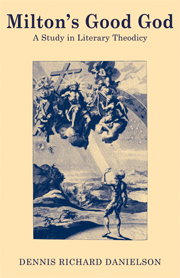Book contents
- Frontmatter
- Contents
- Preface
- 1 The contexts of Milton's theodicy
- 2 God and Chaos
- 3 Assertion and justification: providence and theodicy
- 4 Milton and the Free Will Defense
- 5 Theodicy, free will, and determinism
- 6 Eden and the “soul-making” theodicy
- 7 Paradise Lost and the Unfortunate Fall
- Epilogue
- Appendix: The unfortunate fall of Satan
- Notes
- Selected bibliography
- Index
2 - God and Chaos
Published online by Cambridge University Press: 04 August 2010
- Frontmatter
- Contents
- Preface
- 1 The contexts of Milton's theodicy
- 2 God and Chaos
- 3 Assertion and justification: providence and theodicy
- 4 Milton and the Free Will Defense
- 5 Theodicy, free will, and determinism
- 6 Eden and the “soul-making” theodicy
- 7 Paradise Lost and the Unfortunate Fall
- Epilogue
- Appendix: The unfortunate fall of Satan
- Notes
- Selected bibliography
- Index
Summary
In the beginning God created the heaven and the earth. And the earth was without form, and void; and darkness was upon the face of the deep
Gen. 1:1–21An obvious criticism of any theodicy that bases itself on a doctrine of the Fall, as Milton's by and large does, is that the Fall is an arbitrary place to start one's etiology: It may explain the post–lapsarian condition, but how do you explain the Fall itself? That question leads us back to creation – as it did Milton.
Historically, and perhaps more generally, it is imperative, too, that the Fall be seen in the context of the biblical and more specifically the Reformed pattern of creation, Fall, and Redemption. To cite only one prominent acknowledgment of this pattern, the first page of the Geneva Bible (1560) prefaces Genesis with the following “Argument”:
Moses in effect declareth the things, which are here chiefly to be considered: First, that the worlde and all things therein were created by God, and that man being placed in this great tabernacle of the worlde to beholde Gods wonderful workes, and to praise his Name for the infinite graces, wherewith he had endued him, fel willingly from God through disobedience: who yet for his owne mercies sake restored him to life, and confirmed him in the same by his promes of Christ to come, by whome he shulde ouercome Satan, death and hel.
- Type
- Chapter
- Information
- Milton's Good GodA Study in Literary Theodicy, pp. 24 - 57Publisher: Cambridge University PressPrint publication year: 1982
- 1
- Cited by

